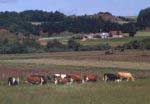 |
Production of steers and use of bioactive forages
Organic meat production in Denmark covers mainly beef and pork. The present market share of organic beef is only two percent, and the supply of organic high quality beef is thus restricted despite a steadily growing number of organic dairy farms. Many bull calves are sold to conventional farms. Economic profitability is seen as a major constraining factor in using dairy breed calves in beef production. However, the interest in organic meat production is increasing, and the need for reliable information on production parameters and strategies is evident.
The objective of this project is to contribute to development of economically viable production systems for organic meat (beef and pork). Emphasis is on steer production that improves animal health and welfare, product quality and nature value of marginal areas by grazing. This may provide a scientific basis for decision support to organic beef producers, and provide future guidelines for management of marginal areas in order to increase biodiversity. Use of marginal areas for grazing combines the need for forage with nature conservation. The investigations include the use of selected bioactive forages with a possible influence on parasite infections, as well as on the quality and flavour of the meat. This approach to improvement of meat quality and to health promotion, particularly parasite control, is novel and may limit the unwanted use of medication. It is thus the intention of the project to find ways of improving the internal and external quality of organic produce.
Publications
Project title
II.3 Organic production of steers and use of bioactive forages in livestock (PROSBIO)
Project leader
Stig Milan Thamsborg, Research professor
The Royal Veterinary and Agricultural University, Department of Animal Science & Health
Grønnegårdsvej 2, DK-1870 Frederiksberg C
Phone: +45 35 28 30 28, Fax: +45 35 28 30 55
E-mail: smt@kvl.dk
Project participants
Anna Bodil Hald, KVL
Laurits Lydehøj Hansen and Kirsten Brandt, DIAS
|